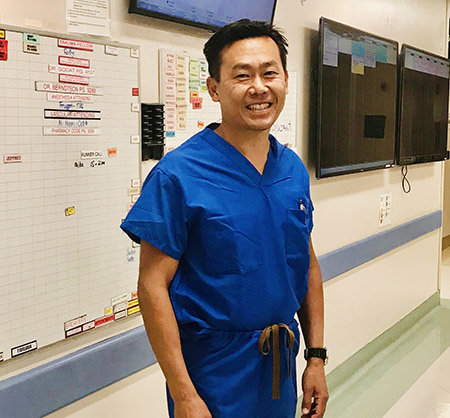UC San Diego Health has enrolled its first patient to evaluate an investigational hand-held technology to non-invasively fragment painful kidney stones. The clinical trial will assess the safety and effectiveness of breaking up kidney stones using acoustic energy. Unlike traditional shockwave technologies, this next-generation form of lithotripsy uses cyclic pulses of ultrasound to fracture kidney stones at lower pressures and potentially with little to no anesthesia.
“Think of an opera singer hitting the right vocal pitch to produce vibrations that stress and break a wine glass,” Roger Sur, MD, urologist and director of the Comprehensive Kidney Stone Center at UC San Diego Health. “Similar concept. The idea behind this investigational technology is to repeatedly stress certain points in the stone that cause it to fracture into small fragments while avoiding damage to surrounding tissue. “
Overall, the primary goal of the feasibility study is to evaluate whether this new technology, called Break Wave, can safely and effectively fragment kidney stones. A secondary goal is to determine if the procedure can be done with minimal or zero anesthesia and in a non-surgical environment.
The multi-center clinical trial is sponsored by SonoMotion, the San Mateo-based company that developed Break Wave based on technology invented at the University of Washington. Up to 30 patients will be recruited internationally for this non-randomized study. Stones ranging in diameter up to 20 millimeters are eligible for the trial.
During the study, participants receive either no anesthesia, light sedation or general anesthesia. The Break Wave device is gently applied on the body over the kidney or ureter. Once positioned, the stone is located via real-time ultrasound image guidance and a low amplitude burst of sound waves is emitted to fragment the stones, which are typically composed of hardened calcium oxalate, calcium phosphate, uric acid, or magnesium-ammonium-phosphate.
Traditional non-invasive treatment for kidney stones is called shock wave lithotripsy. This therapy uses high amplitude shock waves to break up stones. Shock wave lithotripsy often requires the use of x-ray imaging to target the stone, anesthesia, and higher pressures as compared to the Break Wave device. Complications related to these procedures include hematomas, urinary tract injury or obstruction.
“If this study shows that this technology is both safe and effective in fragmenting kidney stones and does so with little to no anesthesia, it could be a game changer for patients,” said Sur who performed the world’s first clinical trial procedure. “While watchful waiting is a good approach for the majority of kidney stones, we are in need of more non-invasive technologies that can treat stones without harming other structures.”
Kidney stones affect 13 percent of men and 7 percent of women in the United States. For many sufferers, kidney stones are not a one-time event; the likelihood of recurrence can be up to 50 percent within five years, and 80 percent within 10 years.
The Comprehensive Kidney Stone Center at UC San Diego Health cares for hundreds of individuals with kidney stones each year. The expert team uses minimally invasive capabilities — such as advanced imaging technology, robotic surgical procedures, dietary changes and medications as part of an individualized treatment plan.
For further information, contact Paul Zupkas, MD, UC San Diego Health study coordinator, at 619-890-5197.
###
Original post https://alertarticles.info
